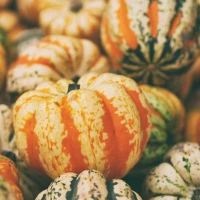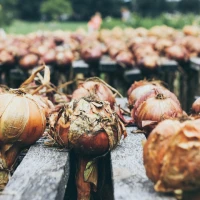Shallots are a staple in kitchens around the world, known for their delicate, sweet flavor and their ability to transform dishes with a touch of elegance. Despite their common place in recipes and on spice racks, shallots often remain underappreciated and misunderstood. This visual guide aims to demystify the shallot, presenting it not just as a simple vegetable, but as a flavor powerhouse that can elevate your cooking to new heights.
As a versatile and essential ingredient, shallots boast a rich history, unique cultivation practices, and a vast array of uses in culinary applications. Let’s peel back the layers of this allium and uncover what makes shallots such a beloved and indispensable component of gastronomy. Whether you’re a seasoned chef or simply a curious food enthusiast, this guide promises to offer valuable insights into the world of shallots.
The Roots of Flavor: What are Shallots?
Shallots, the unsung heroes of flavor, belong to the Allium family, which proudly includes onions, garlic, leeks, and chives. But what sets shallots apart in this aromatic lineage?
History and Origin
Shallots have been flavoring dishes for centuries, with their use dating back to ancient times. They are thought to have originated in Central or Southwest Asia, with the term “shallot” derived from the ancient Canaanite city of Ashkelon, an early trade center for the bulbs. From the Middle East, shallots made their way across Europe and Asia, becoming integral to a diverse array of culinary traditions.
Distinctive Features
The appearance of shallots is similar to that of a small, elongated onion. They have a papery skin that can range from golden brown to reddish-purple, and when peeled, reveal cloves much like that of garlic, rather than the single bulb structure seen in onions. This is one of their visual trademarks that differentiates them in the allium family.
Varieties of Shallots
Shallots come in different shapes, sizes, and shades. Some of the more notable varieties include:
- French Red Shallots: These boast a more intense flavor and are often used in high-end cuisine.
- Dutch Yellow Shallots: A milder option with a robust size, making them versatile and user-friendly in the kitchen.
- Grey Shallots or Griselle: Considered an heirloom variety, these are prized for their rich and deep flavor.
Nutritional Profile
Like their allium cousins, shallots are not just flavorful but also loaded with nutrients:
- High in vitamins and minerals such as vitamin B6, vitamin C, folate, potassium, and manganese.
- Contains dietary fiber which aids in digestion.
- Rich in antioxidants, like quercetin and allicin, which have been linked to various health benefits including reduced inflammation and improved heart health.
Understanding these foundational elements about shallots lays the groundwork for appreciating their use in cooking and the techniques that elevate their flavor.
Growing the Flavor Powerhouse: Shallot Cultivation
The journey of a shallot from farm to kitchen is a fascinating one that involves careful cultivation and harvesting practices to ensure only the best quality bulbs end up in your dishes.
Ideal Growing Conditions
Shallots thrive in temperatures that are neither too cold nor too hot. They require well-drained soil rich in organic matter to grow optimally. Like many alliums, they are sensitive to the amount of daylight they receive, and this influences their growth cycle.
Planting Techniques
A healthy shallot crop begins with proper planting. Shallots are usually planted as sets, which are small bulbs that will multiply into clusters. Farmers plant these sets about an inch deep in the soil with ample space in between for growth.
Harvest and Storage
Come late spring or early summer, shallots are typically ready for harvest. The tops begin to brown and fall over, signaling maturity. Once harvested, shallots must be cured—left to dry in a warm, ventilated space to extend their shelf life. Appropriately cured shallots can last for several months if stored in a cool, dry place.
Understanding the attention to detail required in shallot cultivation accentuates their value and hints at the tantalizing flavors they are set to contribute in culinary uses.
The Art of Using Shallots in Culinary Creations
Shallots are an indispensable ingredient in fine dining and everyday cooking alike, lauded for their ability to impart a mellow yet deep flavor profile unmatched by other alliums. How do chefs and home cooks alike harness the power of shallots in their dishes?
Preparation Techniques
Before shallots can work their magic, they must be properly prepared. Peeling shallots requires a delicate touch to preserve the integrity of the cloves. Once peeled, shallots can be:
- Finely Chopped: To sprinkle raw in salads and dressings for a burst of sharp flavor.
- Sliced: For a more pronounced presence, often sautéed to a soft sweetness.
- Whole Roasted: Unleashing their natural sugars and creating a rich, caramelized treat.
Cooking Applications
Shallots are incredibly versatile and can be used in an array of cooking methods:
- Sautéing: Shallots’ sugars caramelize quickly, adding depth to sauces and bases.
- Roasting: Enhances their sweetness and makes for a succulent addition to roasts.
- Pickling: The acidity of the pickling process complements shallots’ natural zing, making them a tangy topping or side.
- Raw: In fine slices or mince, shallots add a fresh punch to salads and dressings.
Signature Dishes with Shallots
There are certain dishes in which shallots are not just an ingredient but a star:
- Beef Bourguignon: This French classic relies heavily on the flavor of shallots.
- Coq au Vin: The delicate taste of shallots is crucial to this renowned dish.
- Shallot Tarte Tatin: A surprising and mouth-watering dessert twist.
By mastering the art of incorporating shallots’ flavor into these dishes and more, you tap into their full potential, making it clear why they’re considered a cornerstone of flavor in countless cuisines.
The Visual Palette of Shallots in Food Photography
Beyond flavor, the aesthetic appeal of shallots should not be underestimated. With the rise of food blogging and visual recipe sharing, how can the unique look of shallots be captured in a way that is both true to their culinary role and visually enchanting?
Capturing Shallots in Still Life
When photographing shallots, consider the following:
- Use Natural Light: To emphasize the subtle sheen of shallots’ skin.
- Play with Color Contrast: Arrange them against complementary colors for dramatic effect.
- Highlight Texture: Focus on the papery layers and the smooth flesh for a tactile sense.
Crafting the Perfect Shot
In food photography, creating an image that makes viewers almost taste the shallots requires:
- Arrangement: Shallots should be placed artfully, sometimes featuring a cut shallot to display the interior.
- Context: Images can include shallots in different stages of preparation, or alongside ingredients they complement.
- Storytelling: A well-composed photo can narrate the journey from bulb to plate.
Visually, shallots carry a vibrancy and a rustic charm that can make any dish not just taste, but also look, irresistible.
Shallot Storage and Handling Tips
To maximize the life span and flavor of shallots, proper storage and handling are key.
- Keep shallots in a cool, dark place with good air circulation; avoid moisture as it promotes rot.
- Avoid refrigerating raw shallots as the cold and humidity can affect their texture and taste.
- Use a sharp knife for cutting shallots to prevent bruising and preserve their essential oils.
By taking care to store and handle shallots correctly, you can ensure that they maintain their peak flavor and textural integrity.
Conclusion: The Quintessential Culinary Treasure
Shallots hold a revered position in the culinary world, a testament to their nuanced flavor and versatility. From their storied past and delicate growing conditions to the grace they bring to the plate and the visual charm they add to food photography, shallots truly are a visual and flavor powerhouse in the realm of vegetables.
Whether employed for their piquant bite in a fresh vinaigrette or for their sweet, aromatic depth in a slow-cooked stew, shallots carry with them the promise of enhancing any dish. Understanding and appreciating shallots in all their glory is not just an exercise in cooking—it’s a way to savor history, culture, and the fine art of gastronomy. Shallots, in their understated elegance, await their rightful place in the spotlight—unveiled and celebrated as the culinary jewels they truly are.










